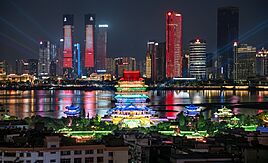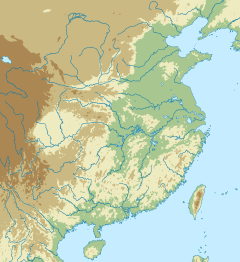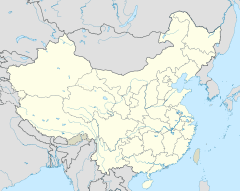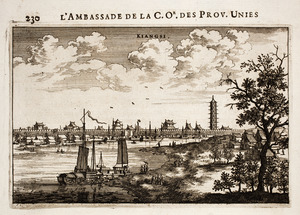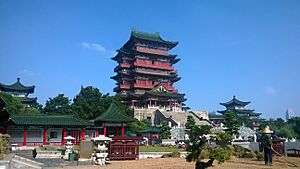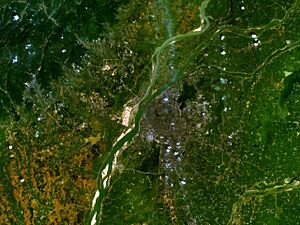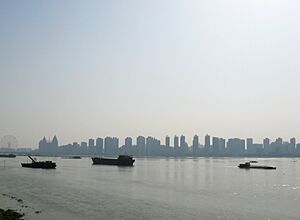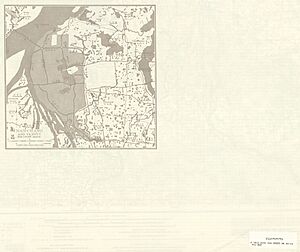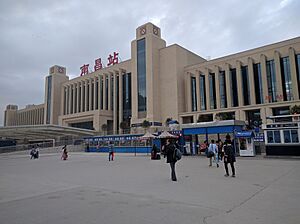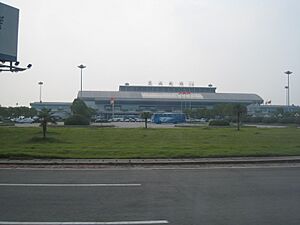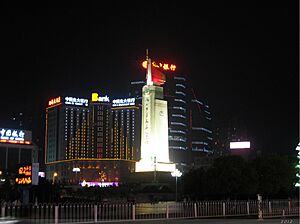Nanchang facts for kids
Quick facts for kids
Nanchang
南昌市
|
|
|---|---|
|
Prefecture-level city
|
|
|
Nanchang Skyline, with the Pavilion of Prince Teng in the front
Sunrise in Nanchang
New Fourth Army Headquarters
Star of Nanchang
Bayi Square
|
|
| Nickname(s):
Hongcheng (洪城 lit. Grand City), Hongdu (洪都 lit. Grand Metropolis), Yuzhang (豫章)
|
|
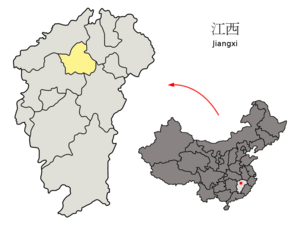
Location of Nanchang City jurisdiction in Jiangxi
|
|
| Country | China |
| Province | Jiangxi |
| County-level divisions | 6 districts, 3 counties |
| Municipal seat | Honggutan District |
| Government | |
| • Type | Prefecture-level city |
| • Body | Nanchang Municipal People's Congress |
| Area | |
| • Prefecture-level city | 7,194 km2 (2,778 sq mi) |
| • Urban | 686 km2 (265 sq mi) |
| • Metro | 4,588 km2 (1,771 sq mi) |
| Elevation | 37 m (122 ft) |
| Population
(2020 census)
|
|
| • Prefecture-level city | 6,255,007 |
| • Density | 869.48/km2 (2,251.93/sq mi) |
| • Urban | 3,929,660 |
| • Urban density | 5,728/km2 (14,836/sq mi) |
| • Metro | 5,382,162 |
| • Metro density | 1,173.10/km2 (3,038.3/sq mi) |
| GDP | |
| • Prefecture-level city | CN¥ 400.0 billion US$ 64.2 billion |
| • Per capita | CN¥ 75,879 US$ 12,183 |
| Time zone | UTC+8 (CST) |
| Postal code |
330000
|
| ISO 3166 code | CN-JX-01 |
| Licence plate prefixes | 赣A, 赣M |
| City Flower | Chinese Rose |
| City Tree | Camphor Laurel |
| Nanchang | |||||||||||||||||||||||||||||
|---|---|---|---|---|---|---|---|---|---|---|---|---|---|---|---|---|---|---|---|---|---|---|---|---|---|---|---|---|---|

"Nanchang" in Chinese characters
|
|||||||||||||||||||||||||||||
| Chinese | 南昌 | ||||||||||||||||||||||||||||
| Literal meaning | "Southern Prosperity" | ||||||||||||||||||||||||||||
|
|||||||||||||||||||||||||||||
Nanchang is the capital city of Jiangxi Province in China. It is located in the north-central part of the province, near the Poyang Lake Plain. To its west are the Jiuling Mountains, and to its east is Poyang Lake. Nanchang is a very important railway hub in Southern China. This is because of its location, connecting the busy East and South China regions.
Nanchang is famous as "the place where the People's Liberation Army was born." This is because the Nanchang Uprising happened here in 1927. This event is seen as the start of the People's Liberation Army. The city is also a major center for scientific research. Nanchang University is located here.
Contents
History of Nanchang
Early Times
The area where Nanchang is today became part of China during the Qin dynasty. This was around 201 BC, during the Han dynasty. The city was named Nanchang, which means "southern flourishing." This name came from a goal to develop southern China.
In AD 589, during the Sui dynasty, Nanchang became known as Hongzhou. After 763, it grew to be the main city of Jiangxi. By the 12th century, Jiangxi was the most populated province in China.
Tengwang Pavilion
The famous Tengwang Pavilion was built in 653. A poet named Wang Bo wrote a classic poem about it in 675. This made the building, the city, and the poet very well-known. The Pavilion has been destroyed and rebuilt many times. Its current look was built in the 1980s.
Later Imperial Periods
In 959, Nanchang was made a special capital city. Later, under the Song dynasty, its name changed back to Hongzhou. During the Yuan dynasty (1279–1368), Nanchang was the capital of Jiangxi Province. This province also included the area of Guangdong at that time.
In the 16th century, Nanchang was a base for a rebellion against the emperor. The city suffered a lot during the Taiping Rebellion (1850–64). Its importance as a trading center also went down. This happened when new shipping routes along the coast became popular. Still, Nanchang remained the most important city in Jiangxi.
Modern Era
On August 1, 1927, the Nanchang Uprising took place. This was a key event organized by the Chinese Communist Party. The communists held the city for only a few days. However, this uprising helped create the People's Liberation Army (PLA).
In 1939, a fierce battle called the Battle of Nanchang happened here. Chinese and Japanese armies fought during the Second Sino-Japanese War.
After 1949, Nanchang became a major industrial city. Before this, it was mostly a city for administration and trade. It now produces cotton textiles and paper. Heavy industry also grew, making agricultural equipment and diesel engines. Nanchang also became a center for making cars and trucks. Today, it also has a large chemical industry and makes medicines.
Geography and Climate
Nanchang is located in southeastern China. It is about 130 kilometers south of the Yangtze River. The city sits on the right bank of the Gan River. This is just below where the Jin River joins it. It is also about 40 kilometers southwest of where the Gan River flows into Poyang Lake.
Nanchang has a humid subtropical climate. This means it has four clear seasons. Winters are short and cool, sometimes with frost. Springs are often cloudy and rainy. Summers are long, hot, and humid. Autumns are warm with less rain. The average temperature for the year is about 18.5°C (65.3°F).
Population and Administration
As of the 2020 census, Nanchang had a population of over 6.2 million people. Most of the people, about 5.3 million, live in the city's urban areas. The majority of the population, 99.2%, are Han Chinese.
Nanchang is divided into several areas. These include 6 districts and 3 counties. The city's government seat is in Honggutan District. These divisions help manage the city and its surrounding areas.
Economy
Nanchang is an important area for farming in Jiangxi province. It produces a lot of grain, rice, and oranges. The Ford Motor Company has a factory in Nanchang. They make Ford Transit vans there.
The city's economy also focuses on making aircraft and cars. Other important industries include metal production, electronics, textiles, and chemicals. Nanchang also has a strong traditional Chinese medicine and pharmaceutical industry. The city is growing very fast economically. It is considered one of the cities with the most potential for future development.
In 2017, the city's total economic output (GDP) was about 500 billion yuan. This was a 9% increase from the year before. The average income per person was about 81,598 yuan.
Industrial Zones
Nanchang has special areas for businesses and factories. These are called development zones.
- Nanchang Export Processing Zone: This zone helps businesses that export goods. It has special rules to make customs easier.
- Nanchang National High-tech Industrial Development Zone (NCHDZ): This is a national-level zone for high-tech companies. It was started in 1991. It covers a large area and is important for Nanchang's industry.
- Nanchang Economic and Technological Development Zone: Another important zone for economic growth and technology.
Transportation
Nanchang has a great location for transportation. It is known for its "three rivers and five lakes." It has become a major transportation hub in China. High-speed railways and airports connect it to important economic regions.
Railways
Nanchang is a key railway hub in southeastern China. Several major railway lines meet here. These include the Beijing–Kowloon Railway and the Shanghai–Kunming railway. The city has two main passenger train stations: Nanchang railway station and Nanchang West railway station. You can take high-speed trains from Nanchang to cities like Hangzhou, Changsha, and Shanghai.
Air Travel
Nanchang Changbei International Airport (KHN) is the main airport. It was built in 1996 and is about 26 kilometers north of the city center. It is the only airport in Jiangxi Province with international flights. The airport connects Nanchang to many major cities in China. In 2017, over 10 million passengers used Nanchang Airport. This made it one of the busiest airports in the country. The airport is currently being expanded and updated.
Roads
Nanchang has a wide network of roads. Several national highways pass through the city. These include National roads No. 105, No. 320, and No. 316. The city also has a round-city highway, G70_01, which opened in 2007. Long-distance buses connect Nanchang to cities both inside and outside Jiangxi Province.
Metro System
The Nanchang Rail Transit is the first subway system in Jiangxi Province. It started operating on December 26, 2015. Nanchang was the 25th city in mainland China to have a metro system. It connects the main downtown area with other parts of the city. Line 1 opened in 2015, and part of Line 2 started trial operations in 2017.
Waterways
Nanchang is located on the Gan River, Fu River, and several lakes. This makes water routes very important for trade and shipping. Nanchang Port is the largest port on the Gan River. You can take boats from here to places like Jinggang Shan and Tengwang Pavilion. Passenger ships also go to Poyang Lake and other attractions.
Landmarks and Attractions
- Tengwang Pavilion: A tall and historic building from 653 AD. It is on the east bank of the Gan River and is one of "the Four Great Towers of China."
- Poyang Lake: The largest freshwater lake in China. It is also known as "the Migrator Birds Paradise" because many birds visit it.
- Star of Nanchang: A huge Ferris wheel in Honggutan District. It was the tallest Ferris wheel in the world from 2006 to 2008.
- Qiushui Square: Opened in 2004, it has the largest musical fountain in Asia.
- Jiangxi Provincial Museum: A museum where you can learn about the history and culture of Jiangxi.
- People's Park: The biggest park in downtown Nanchang, great for relaxing.
- Bayi Square and Memorial: Located in the center of Nanchang. It honors the founding of the People's Liberation Army during the Nanchang Uprising on August 1, 1927.
Education
Nanchang has many colleges and universities:
- Jiangxi University of Finance and Economics
- Nanchang University
- Jiangxi Normal University
- Nanchang Hangkong University
- Jiangxi Agricultural University
- East China Jiaotong University
- East China University of Technology, Nanchang Campus
- Jiangxi Institute of Traditional Chinese Medicine
- Nanchang Institute of Technology
- Jiangxi Science and Technology Normal University
- Jiangxi Manufacturing and Vocational College
- Jiangxi University of Traditional Chinese Medicine
There are also many high schools:
- Nanchang Foreign Language School
- Affiliated Middle School of Jiangxi Normal University
- Nanchang No.2 Middle School
- Nanchang No.1 Middle School
- Nanchang No.3 Middle School
- Nanchang No.10 Middle School
For international students, there is the Nanchang International School.
Notable People
- Hu Hsen-Hsu (1894 – 1968): He was born and grew up in Nanchang. He was a pioneer in studying plants and ancient plants in China.
- Zhi Yueying (born 1961): An educator born in Nanchang.
Sports
Nanchang hosts the Jiangxi International Women's Tennis Open.
Friendship Cities
Nanchang has special friendly relationships with these cities around the world:
Images for kids
See also
 In Spanish: Nanchang para niños
In Spanish: Nanchang para niños


